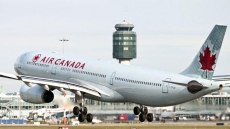HALIFAX — Irving Shipbuilding has started building Canada's first Arctic offshore patrol ship at the company's massive shipyard in Halifax.
Hundreds of employees gathered Tuesday in the new assembly hall as a huge sheet of cut steel was hoisted into place and a special ceremony was held to mark the occasion.
Kevin McCoy, president of Irving Shipbuilding, says welders, pipefitters, marine fabricators and ironworkers are involved in the project, which is on schedule.
"Today is a milestone we have all been anticipating," McCoy said in a statement. "It is a great day to be a shipbuilder in Nova Scotia as we mark the beginning of this generational opportunity."
The company says the ship will the first of up to 21 vessels that will renew Canada's fleet of warships over the next 30 years.
About 900 Irving employees are working on the project at two locations in the Halifax area, but that number is expected to jump to 1,600 over the next two years.
The federal government's $35-billion national shipbuilding strategy saw shipyards chosen to do the work in 2011.
Last September, Prime Minister Stephen Harper announced that the first patrol vessel would be named after Vice-Admiral Harry DeWolf, a Nova Scotia native who was one of Canada's most distinguished sailors during the Second World War. DeWolf's lengthy naval career included command of HMCS St. Laurent and HMCS Haida from 1939 until 1944.
In January, federal officials formally announced that Irving Shipbuilding had been awarded a $2.3-billion build contract for a total six Arctic patrol vessels.
The first patrol ship is expected to be completed in 2018. McCoy has said the final patrol ship will be delivered in 2022.
Irving Shipbuilding says employment at the company is expected to grow to 2,500 when peak production is reached with construction of the larger surface combatant vessels, which will replace Canada's current fleet of Halifax-class frigates and Iroquois-class destroyers.
Irving Shipbuilding, under the name Saint John Shipbuilding, was the lead contractor on the construction of the existing frigates in the late 1980s and throughout the 1990s.




